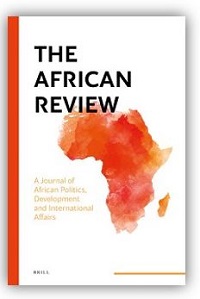Understanding the role of Gender Relations in Radicalising and Recruiting Young Muslim Women in Higher Learning Institutions in Kenya
Abstract
The radicalisation and recruitment of young educated Muslim women is a sensitive and global phenomenon, which is also a major social and security concern within learning institutions. Young Muslims women in higher learning institutions in Kenya have become easy targets for recruitment by violent extremist organisations such as Al-Shabaab and the Islamic States of Iraq and Syria. This is because learning institutions have been identified by these extremist groups as sites of recruitment due to their transitionary, permissive, biographical, secular and socialization space. The presence of radicalised young educated Muslim women is a proof that there is a shifting profile of extremists from focusing on the illiterate to the literate and from male to female recruits. The purpose of this article is to explain why young women at learning institutions are targeted for recruitment by violent extremist groups. It argues that young Muslim women are vulnerable to radicalization and recruitment in higher learning institutions because the recruiters take advantage of their lower level of religious literacy and use patriarchal constructs in their recruitment narrative by manipulating marriage as a Utopian promise to lure young women.
Keywords: Violent extremism, Gender, Kenya, Higher learning institutions, Recruitment
Fatuma A. Ali
Associate Professor, United States International University-Africa, E-mail: fmali@usiu.ac.ke
References
Ali, M. Y. and Bwana, O. M. and Juma, R. A. 2015. eds. BRAVE: Building Resilience Against Violent Extremism Training Manual and Resource Guide, Center for Sustainable Conflict Resolution
(CSCR), ISBN 9966 85605 6.
Ashour, O. 2009. "Votes and Violence: Islamists and The Processes of Transformation", International Centre for the Study of radicalization and Political Violence (ICSR),http://icsr.info/wpcontent/uploads/2012/10/1264507559VotesandViolenceIslamistsandth eProcessesofTransformationOmarAshour.pdf, accessed 14.7.2017.
Borum, R. 2011. "Radicalization into Violent Extremism I: A Review of Social Science Theories, "Journal of Strategic Security 4, no. 4 : 7 €“36.
Brown, K.E. and Saeed, T. 2015. "Radicalization and counter-radicalization at British universities: Muslim encounters and alternatives", Ethnic and Racial Studies, 38:11, 1952-1968, DOI: 10.1080/01419870.2014.911343.
Butale, C. 2017. "The Nexus between Gender Inequality and Violent Extremism in Sub-Saharan Africa", International Association for Political Science Studies (IAPSS), http://www.iapss.org/wp/2017/03/30/the-nexusbetween-gender-inequality-and-violent-extremism-in-sub-saharanafrica/,
accessed 15.7.-2017.
Deutsche Welle. 10.02.2016. "Uganda: 20 years since 'Aboke girls' abduction", http://www.dw.com/en/uganda-20-years-since-aboke-girlsabduction/a-35993023, accessed 10.2.2018.
European Union. 2017. Radicalisation and violent extremism-focus on women: How women become radicalised and how to empower them to prevent radicalisation. Policy Department for Citizen ´s Rights and Constitutional Affairs:
EU.file:///C:/Users/Propietario/Desktop/GENDER%20AND%20EXTREMIS
M%20SEPTOCT%202017/JANUARY202018/IPOL_STU(2017)596838_EN.pdf accessed 10.2.2018.
Hennessy-Fiske, M. 25.01.2015."Female terrorists finding their place in Islamic militants' ranks," Los Angeles Times.http://www.latimes.com/world/europe/la-fg-france-terrorwomen-20150125-story.html, accessed 3.8.-2017.
Neumann, P. 2013, "The Trouble with Radicalization",International Affairs (London), vol 89, no. 4, pp. 873-893. DOI: 10.1111/1468-2346.12049
Neumann, P. 2007. "Recruitment and Mobilisation for the Islamist Militant Movement in Europe." London: King ' s College, December.Publisher?
Ndung ' u, I. and Uyo, S. May 2017."The role of women in violent extremism in Kenya" Institute for Security Studies (ISS),
https://issafrica.org/research/east-africa-report/the-role-of-women-inviolent-extremism-in-kenya, accessed 10.2.2018.
Ndung ' u, I. 2015. "Why are young women drawn to extremism?" Institute for Security Studies (ISS), https://issafrica.org/iss-today/why-are-youngwomen-drawn-to-extremism accessed 26.7.2017.
Odhiambo E. O. and others. 2015. "Domestic radicalisation in Kenya", Global Journal of Interdisciplinary of Social Sciences, (G.J.I.S.S), Vol.4(3):48-56 (May-June), ISSN: 2319-8834
doi:10.5038/1944-0472.4.4.1. http://gifre.org/library/upload/volume/48-56-Domestic-vol-4-3-15-gjiss.pdf, accessed 1.8.-2017.
Ogenga, F.. 2016. "Philosophizing Alternative Pan-African Media and Society Approaches to Countering Female Violent Extremism in Kenya for Peace and Security", Research Paper No. 15 Wilson Center African Program, https://www.wilsoncenter.org/sites/default/files/ogenga_-
research_paper.pdf, accessed 15.7.-2017.
O ' Rourke, L.A. 2009. "What ' s Special about Female Suicide Terrorism?," Security Studies 18, no. 4 681 €“718 Taylor & Francis Group, LLC ISSN: 0963-6412 print / 1556-1852 online DOI: 10.1080/09636410903369084 accessed 14.7.-2017.
Rush, J.P. and Schafluetzel-Iles, E.2008. "Fem Fatales: The Evolution and Significance of Female Involvement in Terrorist Networks and Suicide Bombing", Professional Issues in Criminal Justice (PICJ), Vol 2, Issue, https://kucampus.kaplan.edu/documentstore/docs09/pdf/picj/vol2/issue1/Fem_Fatales.pdf, accessed 30.8.-2017.
Tymstra, T. J. and Heyink, J.W. 1993. "The Function of Qualitative Research.,Social Indicators Research vol. 29 (3).pp?
US Agency for International Development (USAID). 2011. "The Development Response to Violent Extremism and Insurgency", USAID Policy Brief,September.
Downloads
Published
Issue
Section
License
Copyright © by Department of Political Science and Public Administration, University of Dar es Salaam
All rights reserved. No part of this publication may be reproduced or transmitted in any form or by any means, electronic or mechanical, including photocopying, recording, or any information storage or retrieval system, without permission in writing from the publisher, except for short extracts in fair dealing, for research or private study, critical scholarly review or discourse with an acknowledgement.
The African Review: A Journal of African Politics, Development and International Affairs [ISSN 0856-0056 (Print) & ISSN 1821-889X (Online)] is published bi-annually, June and December by the Department of Political Science and Public Administration, University of Dar es Salaam, P.O. Box 35042 €“ Dar es Salaam €“ Tanzania



